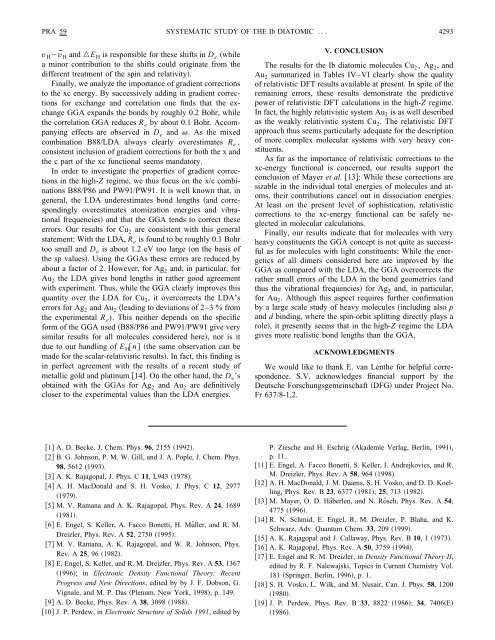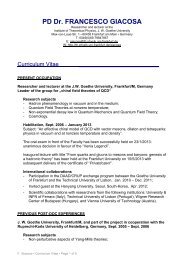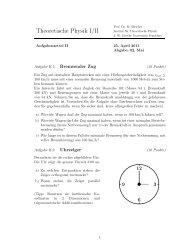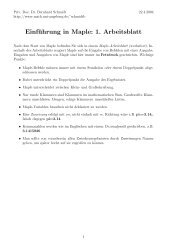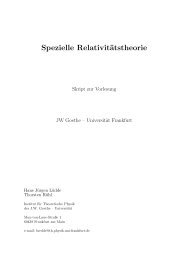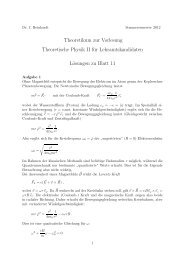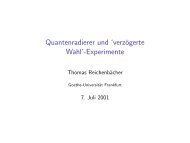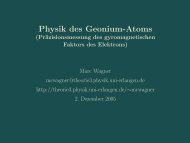S. Varga, E. Engel, W.
S. Varga, E. Engel, W.
S. Varga, E. Engel, W.
You also want an ePaper? Increase the reach of your titles
YUMPU automatically turns print PDFs into web optimized ePapers that Google loves.
PRA 59 SYSTEMATIC STUDY OF THE Ib DIATOMIC . . .<br />
4293<br />
v H ṽ H and E H is responsible for these shifts in D e while<br />
a minor contribution to the shifts could originate from the<br />
different treatment of the spin and relativity.<br />
Finally, we analyze the importance of gradient corrections<br />
to the xc energy. By successively adding in gradient corrections<br />
for exchange and correlation one finds that the exchange<br />
GGA expands the bonds by roughly 0.2 Bohr, while<br />
the correlation GGA reduces R e by about 0.1 Bohr. Accompanying<br />
effects are observed in D e and . As the mixed<br />
combination B88/LDA always clearly overestimates R e ,<br />
consistent inclusion of gradient corrections for both the x and<br />
the c part of the xc functional seems mandatory.<br />
In order to investigate the properties of gradient corrections<br />
in the high-Z regime, we thus focus on the x/c combinations<br />
B88/P86 and PW91/PW91. It is well known that, in<br />
general, the LDA underestimates bond lengths and correspondingly<br />
overestimates atomization energies and vibrational<br />
frequencies and that the GGA tends to correct these<br />
errors. Our results for Cu 2 are consistent with this general<br />
statement: With the LDA, R e is found to be roughly 0.1 Bohr<br />
too small and D e is about 1.2 eV too large on the basis of<br />
the sp values. Using the GGAs these errors are reduced by<br />
about a factor of 2. However, for Ag 2 and, in particular, for<br />
Au 2 the LDA gives bond lengths in rather good agreement<br />
with experiment. Thus, while the GGA clearly improves this<br />
quantity over the LDA for Cu 2 , it overcorrects the LDA’s<br />
errors for Ag 2 and Au 2 leading to deviations of 2–3 % from<br />
the experimental R e ). This neither depends on the specific<br />
form of the GGA used B88/P86 and PW91/PW91 give very<br />
similar results for all molecules considered here, nor is it<br />
due to our handling of E H n the same observation can be<br />
made for the scalar-relativistic results. In fact, this finding is<br />
in perfect agreement with the results of a recent study of<br />
metallic gold and platinum 14. On the other hand, the D e ’s<br />
obtained with the GGAs for Ag 2 and Au 2 are definitively<br />
closer to the experimental values than the LDA energies.<br />
V. CONCLUSION<br />
The results for the Ib diatomic molecules Cu 2 ,Ag 2 , and<br />
Au 2 summarized in Tables IV–VI clearly show the quality<br />
of relativistic DFT results available at present. In spite of the<br />
remaining errors, these results demonstrate the predictive<br />
power of relativistic DFT calculations in the high-Z regime.<br />
In fact, the highly relativistic system Au 2 is as well described<br />
as the weakly relativistic system Cu 2 . The relativistic DFT<br />
approach thus seems particularly adequate for the description<br />
of more complex molecular systems with very heavy constituents.<br />
As far as the importance of relativistic corrections to the<br />
xc-energy functional is concerned, our results support the<br />
conclusion of Mayer et al. 13: While these corrections are<br />
sizable in the individual total energies of molecules and atoms,<br />
their contributions cancel out in dissociation energies.<br />
At least on the present level of sophistication, relativistic<br />
corrections to the xc-energy functional can be safely neglected<br />
in molecular calculations.<br />
Finally, our results indicate that for molecules with very<br />
heavy constituents the GGA concept is not quite as successful<br />
as for molecules with light constituents: While the energetics<br />
of all dimers considered here are improved by the<br />
GGA as compared with the LDA, the GGA overcorrects the<br />
rather small errors of the LDA in the bond geometries and<br />
thus the vibrational frequencies for Ag 2 and, in particular,<br />
for Au 2 . Although this aspect requires further confirmation<br />
by a large scale study of heavy molecules including also p<br />
and d binding, where the spin-orbit splitting directly plays a<br />
role, it presently seems that in the high-Z regime the LDA<br />
gives more realistic bond lengths than the GGA.<br />
ACKNOWLEDGMENTS<br />
We would like to thank E. van Lenthe for helpful correspondence.<br />
S.V. acknowledges financial support by the<br />
Deutsche Forschungsgemeinschaft DFG under Project No.<br />
Fr 637/8-1,2.<br />
1 A. D. Becke, J. Chem. Phys. 96, 2155 1992.<br />
2 B. G. Johnson, P. M. W. Gill, and J. A. Pople, J. Chem. Phys.<br />
98, 5612 1993.<br />
3 A. K. Rajagopal, J. Phys. C 11, L943 1978.<br />
4 A. H. MacDonald and S. H. Vosko, J. Phys. C 12, 2977<br />
1979.<br />
5 M. V. Ramana and A. K. Rajagopal, Phys. Rev. A 24, 1689<br />
1981.<br />
6 E. <strong>Engel</strong>, S. Keller, A. Facco Bonetti, H. Müller, and R. M.<br />
Dreizler, Phys. Rev. A 52, 2750 1995.<br />
7 M. V. Ramana, A. K. Rajagopal, and W. R. Johnson, Phys.<br />
Rev. A 25, 961982.<br />
8 E. <strong>Engel</strong>, S. Keller, and R. M. Dreizler, Phys. Rev. A 53, 1367<br />
1996; in Electronic Density Functional Theory: Recent<br />
Progress and New Directions, edited by by J. F. Dobson, G.<br />
Vignale, and M. P. Das Plenum, New York, 1998, p. 149.<br />
9 A. D. Becke, Phys. Rev. A 38, 3098 1988.<br />
10 J. P. Perdew, in Electronic Structure of Solids 1991, edited by<br />
P. Ziesche and H. Eschrig Akademie Verlag, Berlin, 1991,<br />
p. 11.<br />
11 E. <strong>Engel</strong>, A. Facco Bonetti, S. Keller, I. Andrejkovics, and R.<br />
M. Dreizler, Phys. Rev. A 58, 964 1998.<br />
12 A. H. MacDonald, J. M. Daams, S. H. Vosko, and D. D. Koelling,<br />
Phys. Rev. B 23, 6377 1981; 25, 713 1982.<br />
13 M. Mayer, O. D. Häberlen, and N. Rösch, Phys. Rev. A 54,<br />
4775 1996.<br />
14 R. N. Schmid, E. <strong>Engel</strong>, R. M. Dreizler, P. Blaha, and K.<br />
Schwarz, Adv. Quantum Chem. 33, 209 1999.<br />
15 A. K. Rajagopal and J. Callaway, Phys. Rev. B 10, 11973.<br />
16 A. K. Rajagopal, Phys. Rev. A 50, 3759 1994.<br />
17 E. <strong>Engel</strong> and R. M. Dreizler, in Density Functional Theory II,<br />
edited by R. F. Nalewajski, Topics in Current Chemistry Vol.<br />
181 Springer, Berlin, 1996, p.1.<br />
18 S. H. Vosko, L. Wilk, and M. Nusair, Can. J. Phys. 58, 1200<br />
1980.<br />
19 J. P. Perdew, Phys. Rev. B 33, 8822 1986; 34, 7406E<br />
1986.


